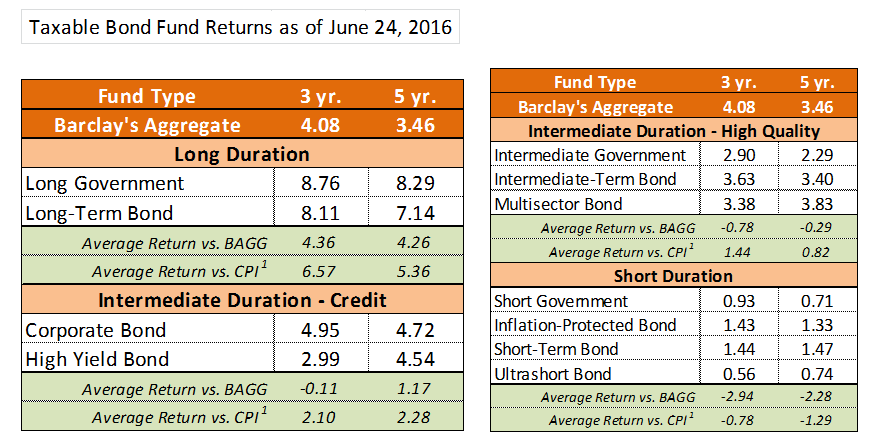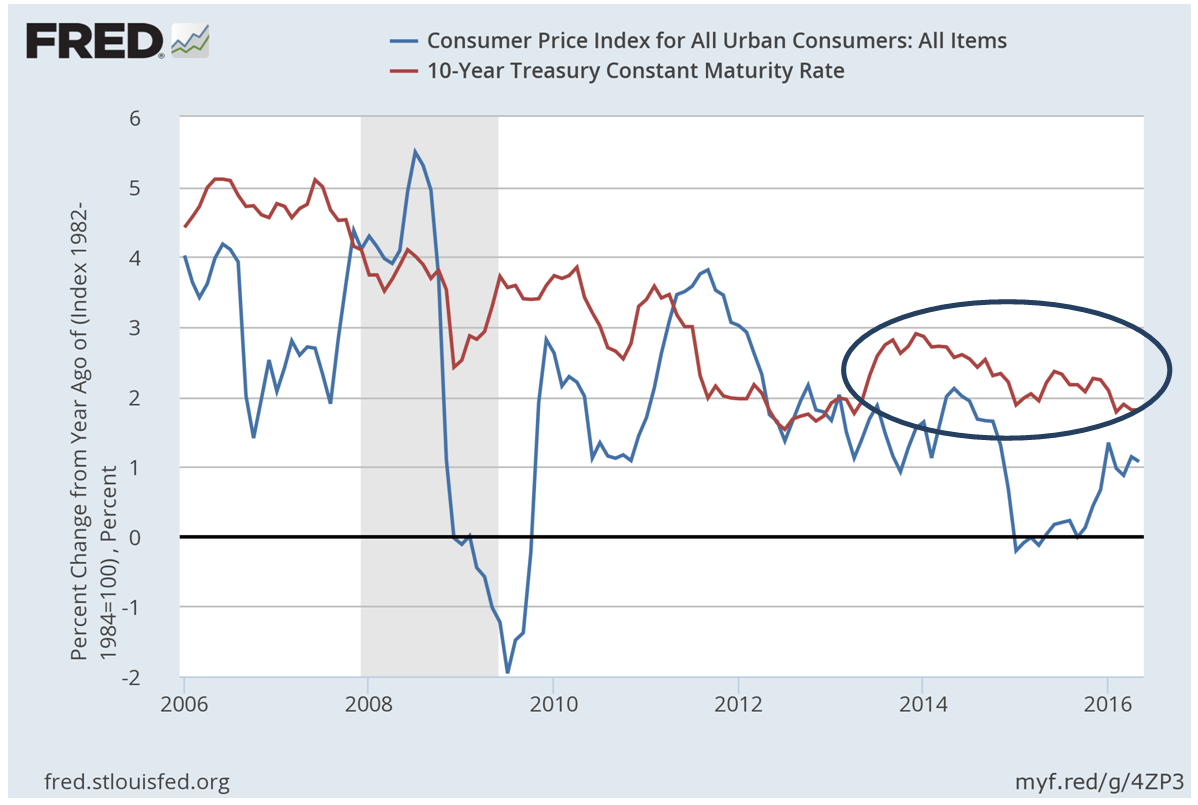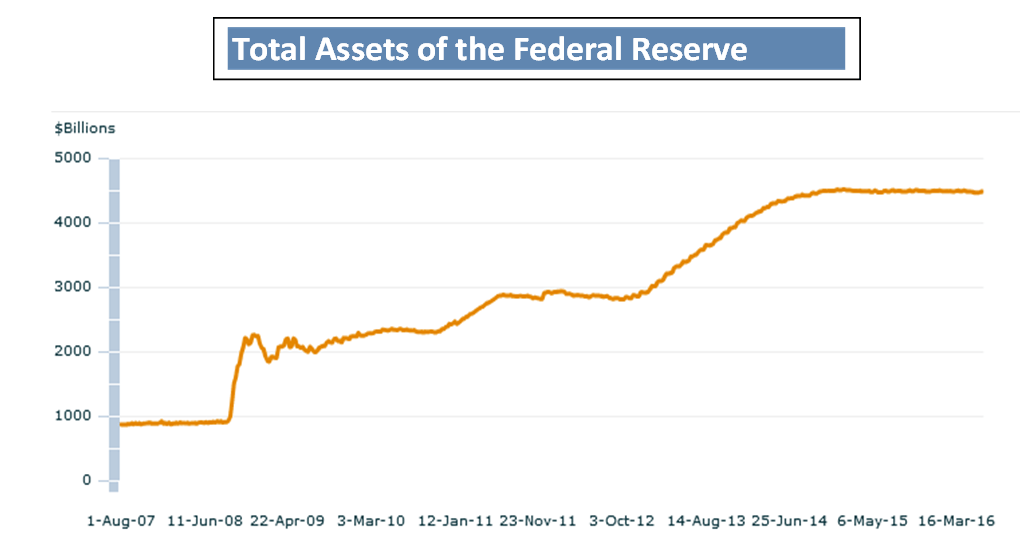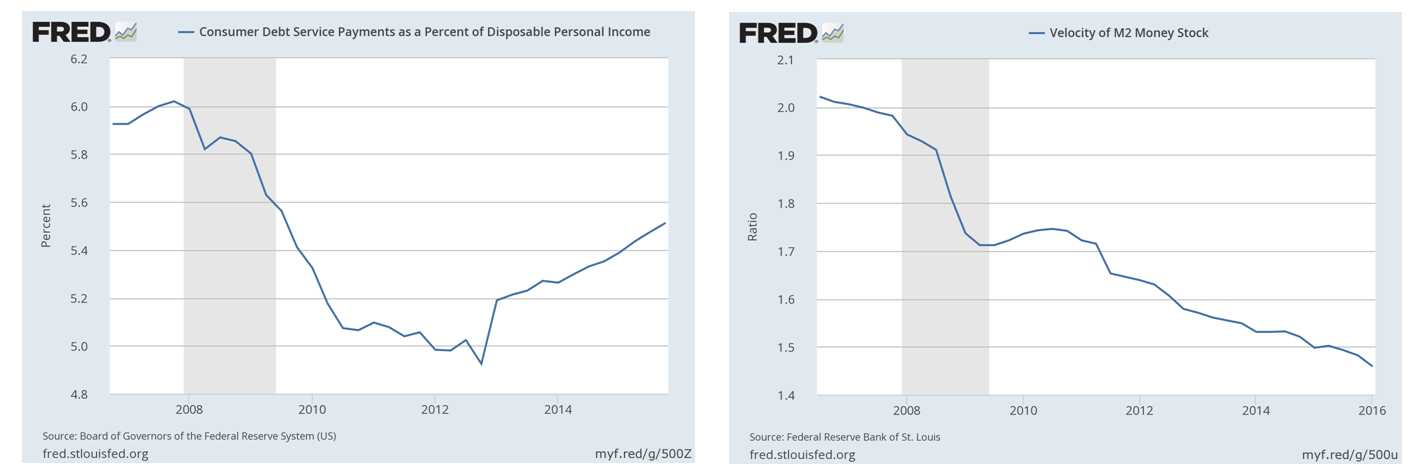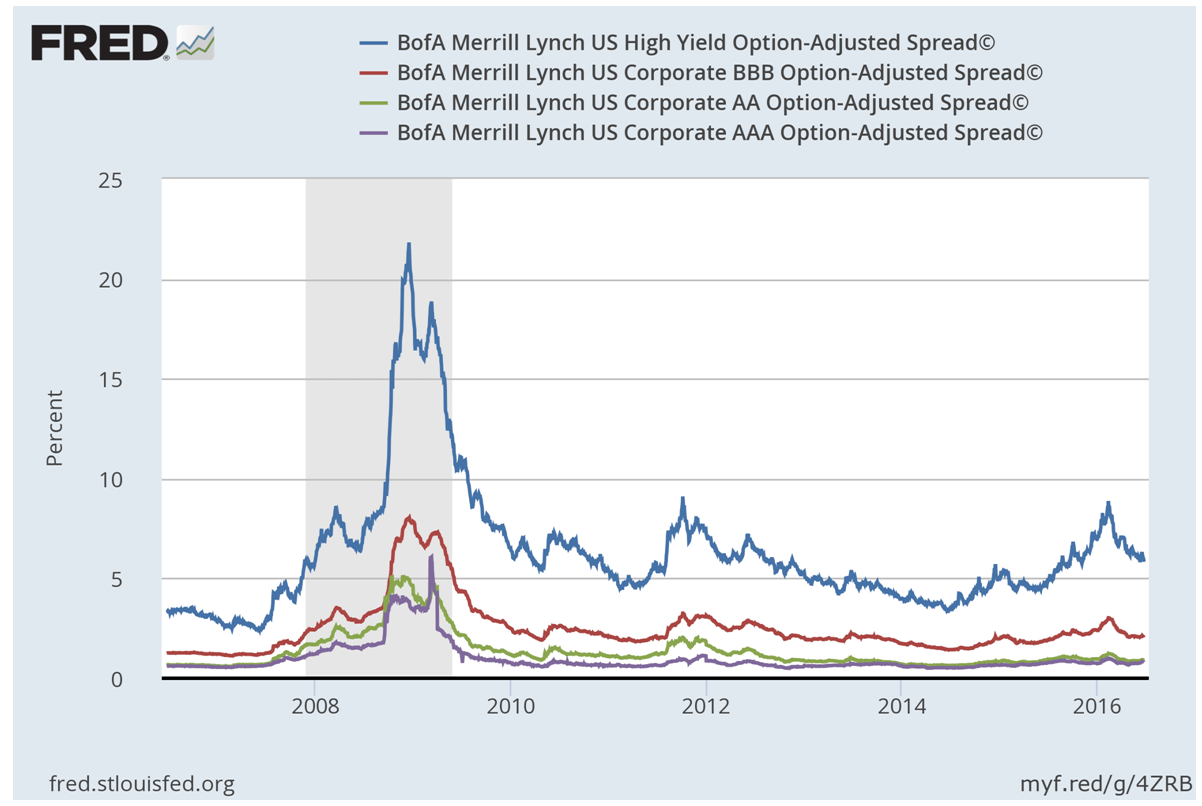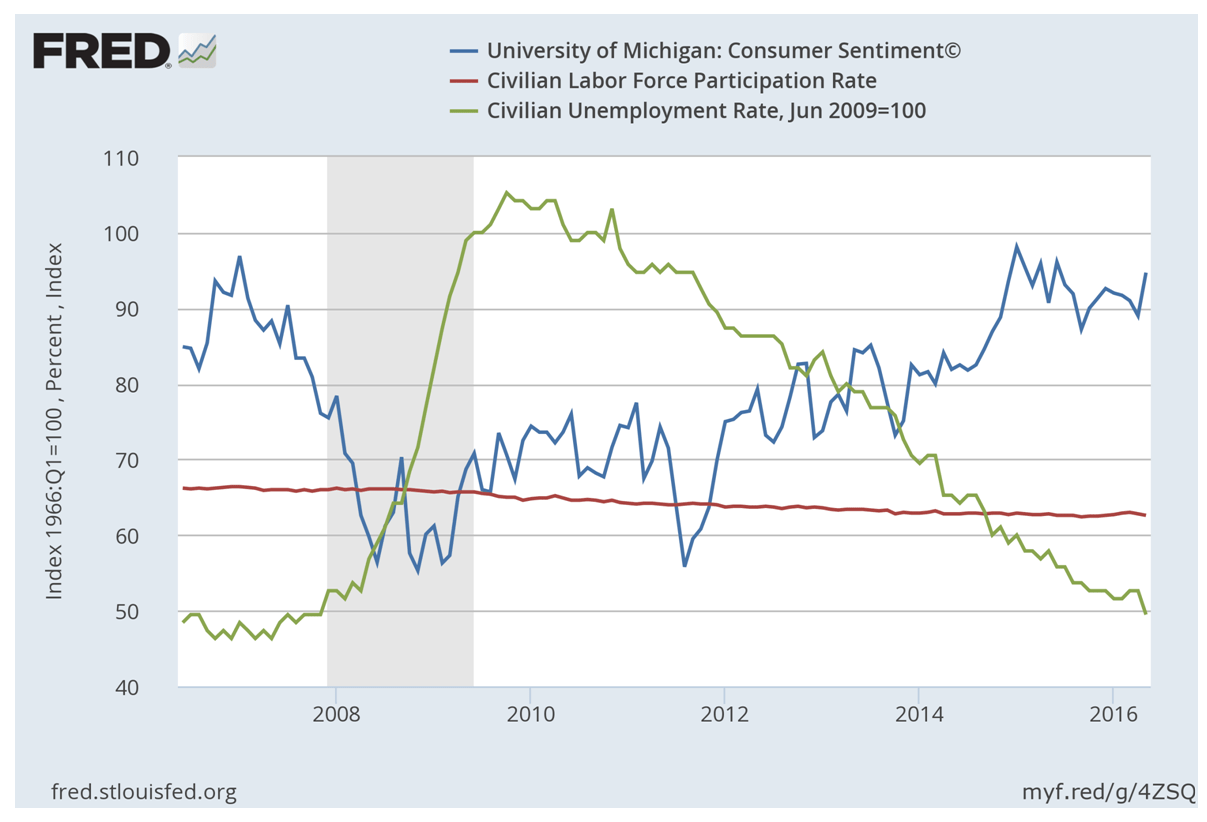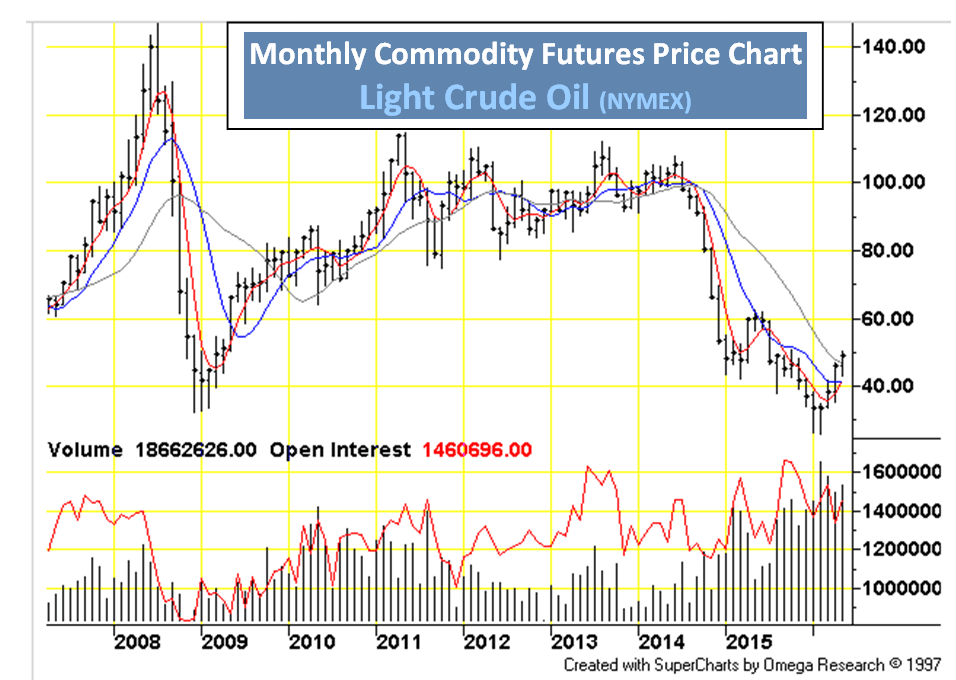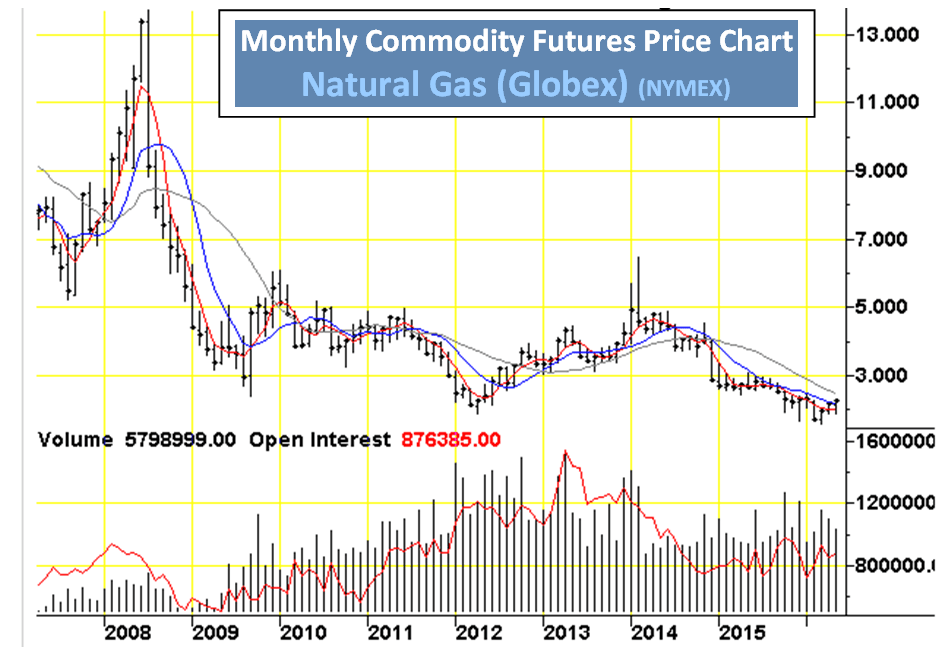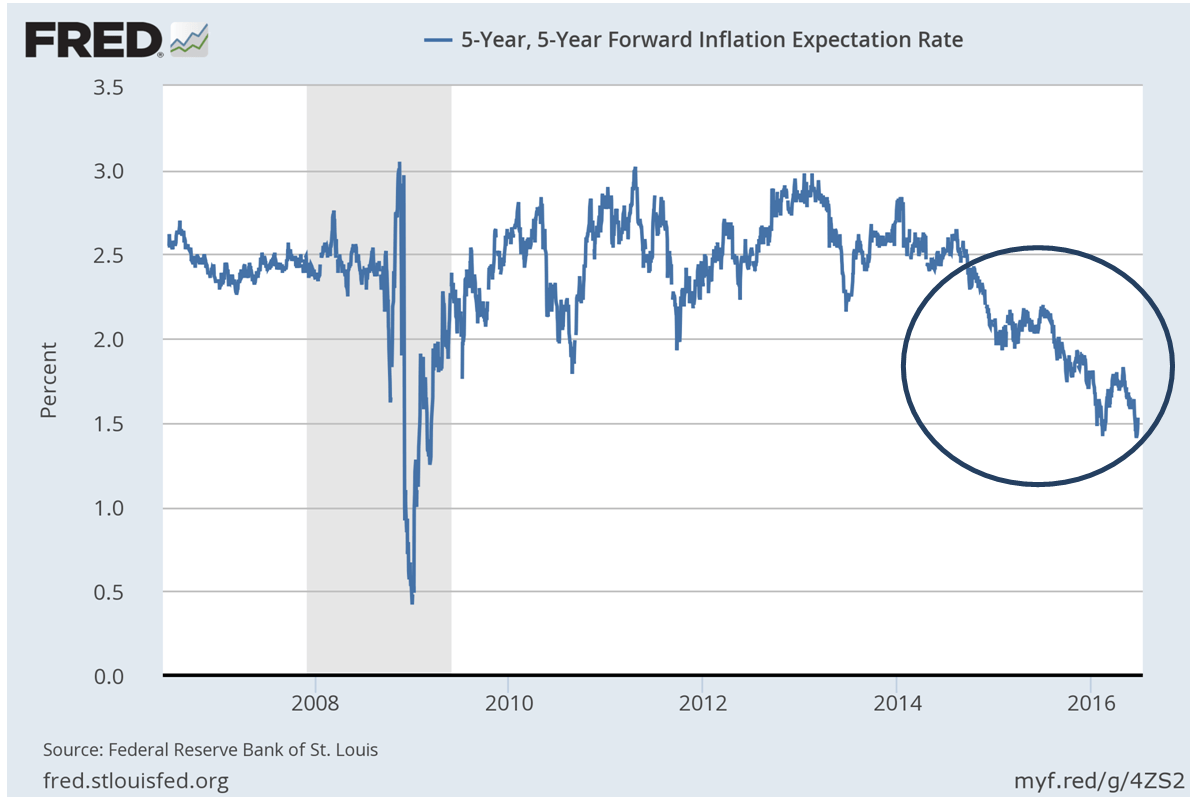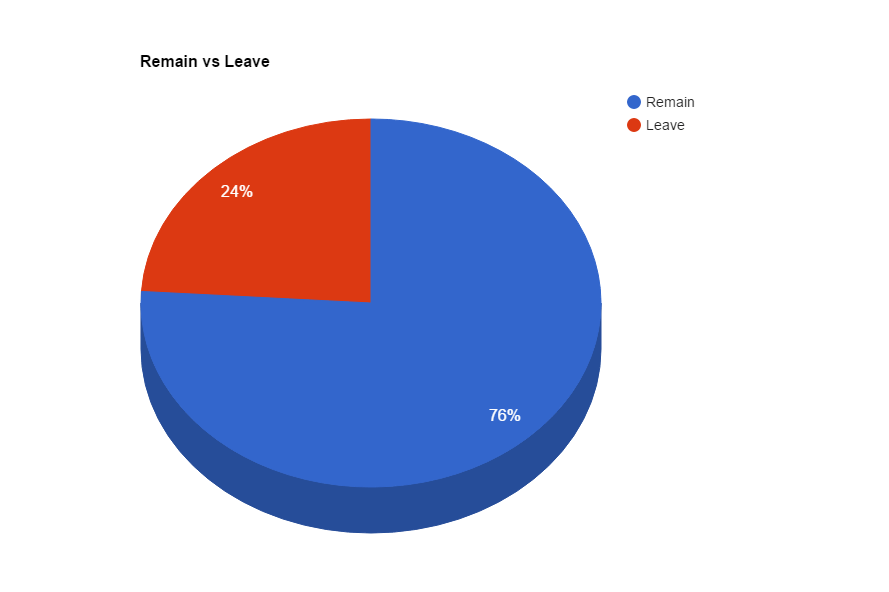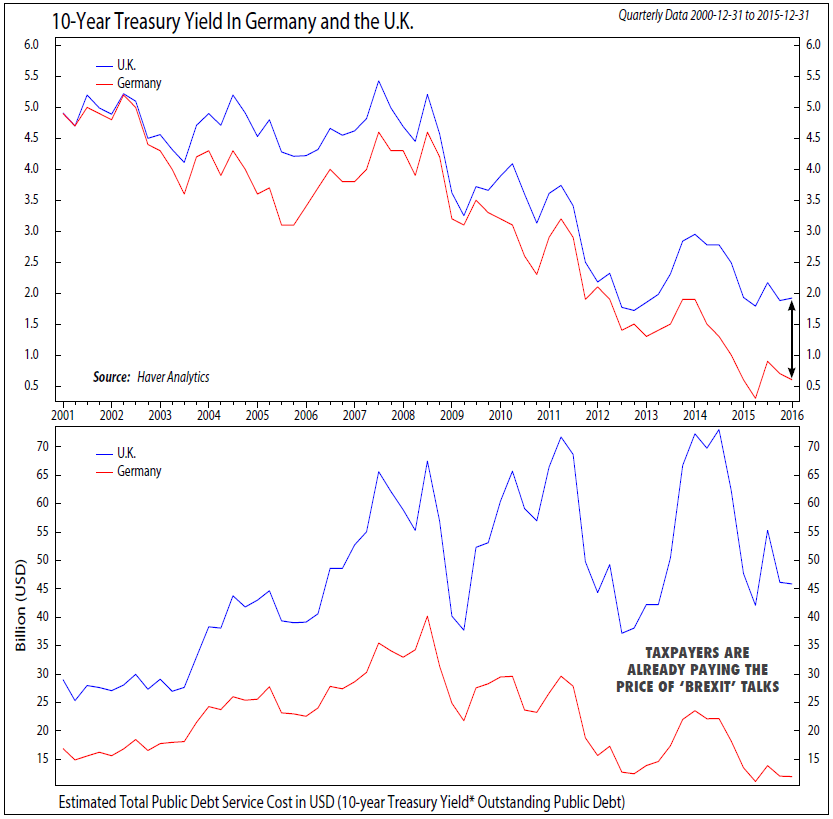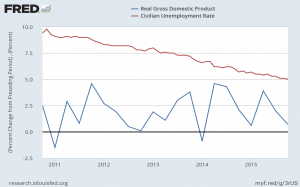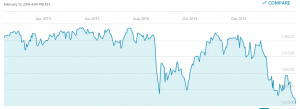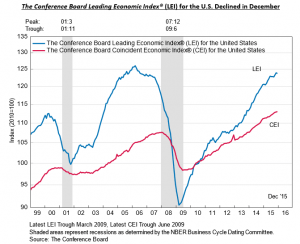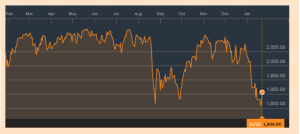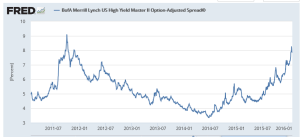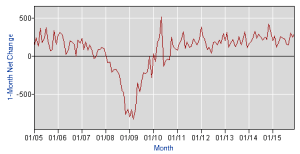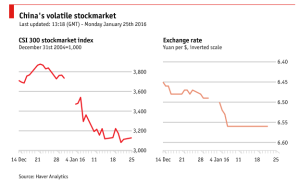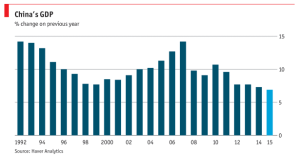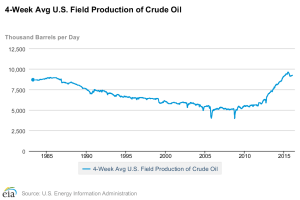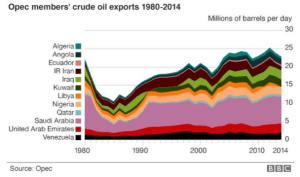Why Aren’t Interest Rates Going Up?
/in Education, General, Investing /by Marcia ClarkInterest Rates, Inflation, and Monetary Policy: Why aren’t U.S. interest rates going up?
Our topic today is interest rates, inflation, and monetary policy. The question we will attempt to answer is: When are interest rates in the United States finally going to rise?
Defensive Strategies Depress Returns
If you’re like most bond investors, you’ve been expecting interest rates to rise for over 2 years now. As a prudent investor, you’ve been holding the duration, or interest rate risk, of your portfolios shorter than usual to protect against falling prices when rates rise. Unfortunately, the result of your prudent behavior has been to underperform standard indexes such as the Barclays U.S. Aggregate Bond index. And if your portfolio is focused primarily on safe assets such as U.S. Treasuries, all but the longest maturity funds struggled to provide a return even modestly better than inflation.
Source: http://news.morningstar.com/fund-category-returns/ and https://fred.stlouisfed.org
1Author’s calculations
While short-term rates have indeed risen with the Federal Reserve rate hike in December 2015, interest rates for Treasuries maturing in 10 years and beyond have actually fallen by an average of more than -0.50% over the past 3 years. Granted, this article was written the day after the British referendum to exit the European Union, which caused global stock markets to tumble and U.S. Treasury yields to fall. If we measure the change in yields as of June 23, 2016 when most experts expected the British to vote to remain in the E.U., long term interest rates have still fallen an average of -0.37% since January 2013.
 Source: www.treasury.gov
Source: www.treasury.gov
In contrast to the lack of upward movement in nominal interest rates, real yields – nominal yields adjusted for inflation – have risen across all maturities in recent years, albeit from an extremely low starting point. As of January 2, 2013 real yields for 5-year Treasury bonds were nearly -1.50%, whereas by June 24, 2016 5-year real yields are only negative -0.50%. And if you were willing to invest for 20 or 30 years, you could earn the princely sum of approximately +0.35% to +0.75% real yield as of January 2013 and June 2016, respectively.
If we take a longer term perspective and look back 10 years, we observe an enviable real rate of approximately 2.5% across maturities from 5 years to 30 years! At today’s paltry real yields of less than 1%, it seems unsustainable to invest hard-earned funds for 5 years or more and barely keep up with inflation. Surely interest rates must return to more normal levels eventually.
But when will that long-awaited time finally arrive?
Building Blocks of Interest Rates
To gain some insight into the drivers of interest rates, let’s take a moment to review the building blocks using what I like to call my ‘interest rate birthday cake’.
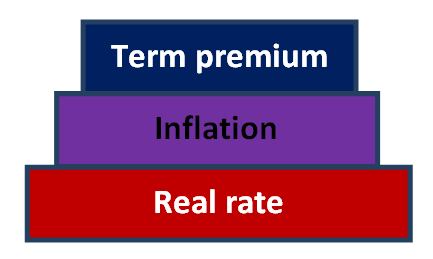
Theory would have us believe that the minimum return investors will accept is a modestly positive ‘real return’, historically between 1.0% and 2.5%. If you add a maturity term premium and inflation expectations to the real rate, the result is the ‘risk free’ rate of interest, which we typically consider the U.S. Treasury yield curve.
The average annual inflation rate from 2006 to 2016 was 1.93%¹, so we could expect the risk free rate of interest over that time period to be approximately 3% to 4.5%. And yet 10-year Treasury yields are currently hovering below 2%, while 30-year yields stand at approximately 2.5%. In fact, 10-year Treasury rates have been falling ever since the ‘taper tantrum’ in mid-2013 as the U.S. economy continues to struggle to sustain momentum after the financial crisis of 2008-2009.
¹Source: U.S. Bureau of Labor Statistics
Let’s not forget the aggressive monetary policy actions of the Federal Reserve bank since the financial crisis. The unprecedented amount of monetary stimulus has long been expected to cause inflation, and yet the only result to date has been to keep the U.S. economy from stalling.
Source: http://www.federalreserve.gov/monetarypolicy/bst_recenttrends.htm
Why Has Aggressive Monetary Policy Not Sparked Inflation?
In times past economists observed a fairly reliable relationship between ‘easy money’ and the ‘velocity of money’, or the amount of times a single dollar changes hands. It is the velocity of money that traditionally puts pressure on prices of goods and services.
But as bank lending standards and capital requirements remain strict, consumer debt levels low, and with the ‘shadow banking system’ taking the place of traditional lenders, the velocity of money has been on a steady decline. Consequently, the impact of monetary policy on the economy has diminished.
So if yields on Treasury securities remain stagnant, where else can we look for pressure on interest rates? One answer is the market appetite for risk – what Keynesian economists term ‘animal spirits’. The layers of my ‘interest rate birthday cake’ related to market risk appetites are default risk, liquidity risk, call risk, and others.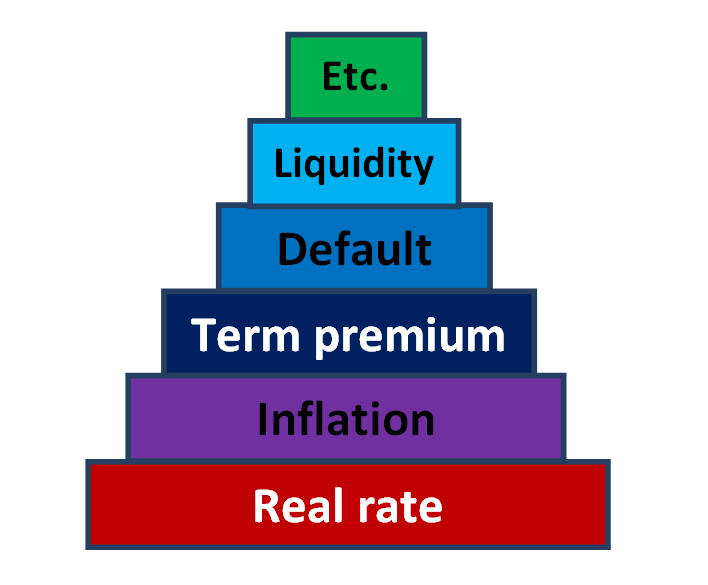
The term ‘animal spirits’ is used to describe human emotions that drive consumer confidence. Rising consumer confidence can increase the general level of economic activity if individuals feel wealthier and purchase more goods and services. If consumer demand grows sufficiently, prices of goods and services will increase, as will the general level of interest rates.
Chasing Yield – Investors Look to Corporate Bonds
If we look to Treasury yields for the risk-free interest rate, corporate bond yields should reflect a risk-adjusted rate of interest for various levels of default risk. In recent years, investors with an appetite for risk had found opportunities in low-quality corporate bonds, only to be traumatized in late 2015 and early 2016 as the precipitous drop in oil and gas prices put extreme pressure on the profitability of the energy sector of the U.S. economy. Because the credit quality of many smaller oil and gas producers was below investment grade, the high-yield sector of the bond market was particularly hard hit.
Option-adjusted yield spreads for BBB-rated corporate bonds – the additional yield above the yield of a matched-maturity Treasury – averaged approximately 1.75% in 2006-2007, prior to the financial crisis. In 2015-2016, BBB spreads averaged 2.31%. It seems investors are being fairly compensated for default risk at the current level of yields, despite a rather bumpy ride along the way.
Traditional Drivers of Inflation Are Absent
So with this understanding of the building blocks of interest rates, can we answer the question of why Treasury yields remain stubbornly at levels barely above inflation?
The answer lies in the middle block of the interest rate pyramid: inflation. More precisely, the market’s expectation for future levels of inflation.
As you may recall from your Econ 101 course in school (assuming our readers stayed awake during class!), inflation typically occurs when either, 1) input prices are rising, causing manufacturers and service providers to increase their finished goods prices to the extent possible, or 2) consumer demand for goods and services exceeds the current supply, enabling manufacturers and service providers to increase their prices.
Though employment and consumer sentiment in the U.S. have certainly improved since the financial crisis of 2008-2009, the persistent trend of lower employment participation is thought to dampen the impact of the current, nominally low, unemployment rate relative to previous economic cycles.
Even though the recent drop in oil and gas prices has stabilized, these essential commodities remain at historically low levels enabling manufacturing, transportation, and leisure travel firms to keep prices low.
Source: futures.tradingcharts.com
So when are these competing forces going to settle out and the long-awaited inflation pressures manifest themselves? Not any time soon, if the forward inflation rate expectations published by the Federal Reserve Bank of St. Louis are any guide.
If inflation pressures are indeed muted on both the supply and demand fronts, and risk appetites are being satisfied with the current level of yield spreads, it is difficult to see where inflation pressures, and therefore interest rate increases, are likely to arise in the near term.
And yet investors cannot endure miniscule real yields indefinitely. Surely there must be something else keeping interest rates low?
As Long as U.S. Treasury Bonds Remain a Safe Haven, Treasury Yields will Remain Low
The final piece in the interest rates puzzle comes from outside the ‘birthday cake’; in fact, outside the U.S. entirely. The final piece is the capital ‘flight to safety’ as international investors seek positive returns amid a global economic slowdown and negative interest rates elsewhere in the world.
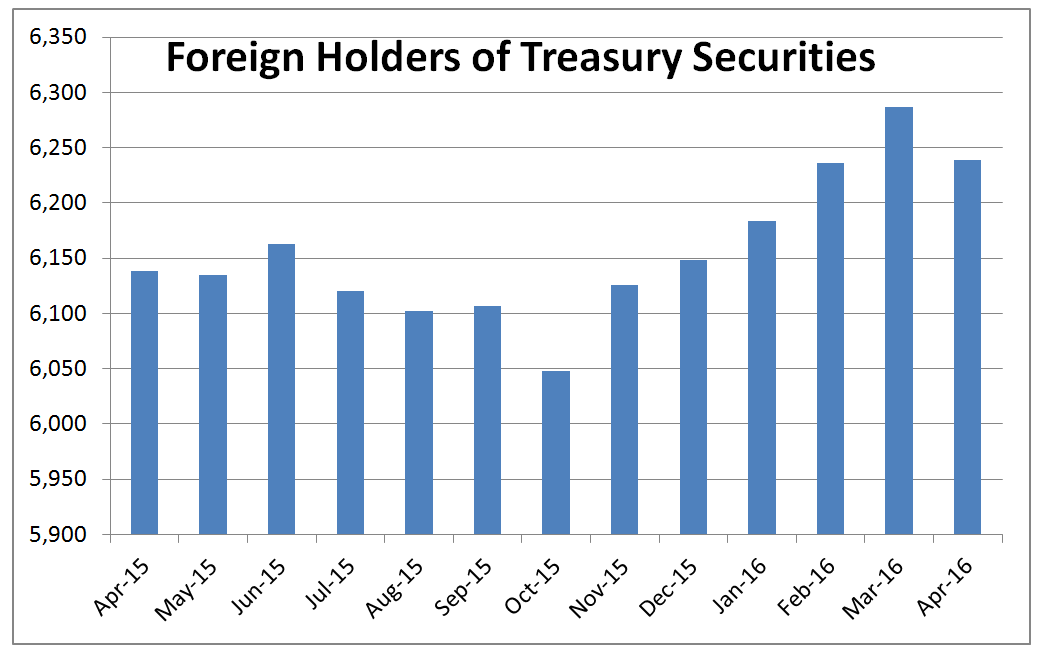 Source: U.S. Bureau of Labor Statistics
Source: U.S. Bureau of Labor Statistics
Given the economic uncertainty caused by the British referendum to leave the European Union, and the dearth of alternative ‘safe haven’ investments, we should expect demand for U.S. securities to remain strong over the near term. Continuing demand for U.S. Treasuries, even at historically low yields, coupled with muted economic activity dampening inflation pressures, means U.S. interest rates can remain low for the foreseeable future.
Eventually, foreign economies should recover and demand for U.S. Treasury securities should fall, pushing yields up to more normal levels as global economic activity strengthens.
But as long as the U.S. is ‘the only game in town’, prudent investors can legitimately maintain the maturities of their portfolios near- to above the standard market index to capture a positive inflation and term premium while awaiting calmer global markets sometime in the intermediate future.
Marcia Clark is an Investment Advisor Representative of Warren Street Wealth Advisors, a Registered Investment Advisor. The information posted here represents her opinions and is not meant as personal or actionable advice to any individual, corporation, or other entity. Any investments discussed carry unique risks and should be carefully considered and reviewed by you and your financial professional. Nothing in this commentary is a solicitation to buy, or sell, any securities, or an attempt to furnish personal investment advice. We may hold securities referenced in the blog and due to the static nature of content, those securities held may change over time and trades may be contrary to outdated posts.
Brexit, Bremain, Blah, Blah, Blah…
/in Education, General /by Blake StreetLast week we watched our version of “The City” lose in Game 7 of the NBA Finals, after blowing a 3-1 lead in the series. This week we watch as London, aka, “The City” and the U.K. at large enter their own final referendum homestand on whether to leave or remain in the European Union. Whether the U.K. stays or leaves, most of this outcome will be short term noise, and will deliver little long term impact in our opinion. Similar to how Cleveland winning a championship has their town in hysterics right now, it still won’t change the fact that their rivers light on fire.
As the clock ticks down, most polls show a healthy balance of IN or OUT voting leading to a proverbial coin flip for the U.K referendum. Consult the odds makers or gambling experts and you’ll get a slightly more confident story for the U.K to remain in the European Union. Let’s see where the money is:
Source: http://www.oddschecker.com/politics/british-politics/eu-referendum/
If the masses turn out to be asses in betting, which would not be a first, what ultimate impact would a “Brexit” have on the EU or U.K. as a whole? Your guess is as good as mine at this point. A successful “Brexit” vote would start a minimum two year process described in Article 50 of the Lisbon Treaty in which E.U. treaties would still apply as negotiations were carried out to determine how the exit is ultimately handled. Big takeaway here is we’re not dealing with a binary event where a switch is flipped and suddenly everything we know about the E.U. changes overnight.
One of the larger talking points we hear discussed is how the U.K. will lose the majority of existing trading agreements and will be on an economic island. This is simply just not true. Sure the U.K. will need to go back to the negotiation table but they’ll have ample opportunity to continue relationships with the common market via the European Economic Area, European Free Trade Area, and even other more regional trade groups. Here’s an example of how many tangled webs one can weave:

Source: Wikipedia
One could argue, and it is our personal sentiment, that much of the market is already pricing in a “Brexit” discount. It appears that the consensus view is that the U.K. would bear the brunt of the near term pain from an exit. This risk premium can be viewed in the form of currency volatility of the British Pound relative to the Euro as of late, shrinking British equity premiums relative to Eurozone stocks, and last but not least higher relative interest rates that lead to increased debt servicing costs. The U.K. and Germany for example have similar public debt loads, but it costs the U.K. approximately an extra $33 billion a year to service its public debt load.
Source: Haver Analytics, Ned Davis Research
Having seen that a “Brexit” discount may already be priced, whether it passes or not, we remain committed to our international holdings and will likely take any near term dip as an opportunity to buy into weakness. Ideally, a remain vote instills confidence in some of the countries on the E.U. periphery that are struggling with structural reform and the European Union as a whole can get back to trend level growth. Something we’ve been patiently waiting for now for years.
All in all, a small part of me will be sad to see the “Brexit” vote come and go, it was a welcome distraction from the impending circus of an election the United States is about to endure. On that note, my counsel remains the same, turn off the TV talking heads, spend time with those you love, grow your value in the workplace, and be a strong steward of your wealth. That’s what we’ll be doing.
Respectfully yours,
Blake Street, CFP®
Retirement Planning Isn’t Just For “Retirees”
/in Basic, Education, General, Investing /by Cary FacerRetirement Planning Isn’t Just for “Retirees”
By: Joe Occhipinti
When people discuss the topic of saving or planning for retirement, the picture that often comes to mind is that of an employee that has been working for the same company for 20+ years and is on the verge of retirement.
When I hear about planning and saving for retirement, I find myself thinking about those who are 20+ years away and need to make the most of one variable that cannot be replaced – time.
Time is precious, and when it comes to preparing for retirement making up for lost time is one of the most difficult things to do. One of the most basic ways we see this is employees missing out on years of 401(k) matching contributions from their employer. A match can be a 100% return on your investment, assuming you are fully vested. That’s a tough return to beat in any financial market.
Too often financial planning and saving for retirement gets thrown to the wayside as something that can be put off for another year. For some, that could be an additional 6% of their salary they are choosing to forgo in their 401(k). If you got an additional 6% of your salary per year added to your retirement account, then how much sooner do you think you’ll be able to retire? How much stronger would your retirement look?
The other key piece of a strong retirement is a financial plan. A sound financial plan should you help surface all facets of your financial picture and ultimately how each piece helps or hinders you from achieving your long term goals. This includes budgeting, savings, investing, and managing risk.
Debt is probably the most often overlooked and underestimated piece of planning. Holding on to excessive debt during your working years can really put a damper on your ability to retire, especially if you have a large amount prior to retirement. Don’t let lack of planning be the sole reason for you to not get the retirement you’ve been dreaming of.
The final thoughts I will leave you with are: 1) Do I want to retire? 2) If I begin contributing to my 401k today, then how much do my chances of a successful retirement increase? 3) Am I managing debt appropriately? 4) Have I put enough time into financial planning to build a strong retirement?
Take the necessary steps to put you on track for retirement, whether that’s 2 or 20 years away.
Joe Occhipinti
Wealth Advisor
Joe@Warrenstreetwealth.com
714.823.3328
Investment Advisor Representative, Warren Street Wealth Advisors, LLC., a Registered Investment Advisor.
The information posted here represents opinions and is not means as personal or actionable advice to any individual, corporation, or other entity, Any investments discussed carry unique risks and should be carefully considered and reviewed by you and your financial professional. Nothing in this presentation is a solicitation to buy, or sell, any securities, or an attempt to furnish personal investment advice. We may hold securities referenced in the presentation and due to the static nature of content, those securities help may change over time and trade may be contrary to outdated posts.
National Lineman Appreciation Day
/in Basic, General /by Cary FacerWe at Warren Street Wealth Advisors want to personally thank all of the lineman out there in the world.
These brave people are on call 24/7, 365 to make sure that we still can still have power in all of our house, along with all the other luxuries we enjoy in our home.
From all of us at Warren Street, thank you for all that you do. We greatly appreciate it.
Are We Done Yet?
/in Education, Financial Planning, General, Investing /by Marcia ClarkFebruary 12, 2016 by Marcia Clark, CFA
On January 26, 2015, I wrote an article questioning the relationship between falling oil prices, slowing Chinese GDP, and the precipitous decline in the U.S. stock markets. I counseled readers to take a breath, that the stock market turmoil was overdone and the U.S. economy was secure.
Shortly after my article, the S&P 500 index rebounded from 1903.63 to 1949.24 as on January 29th the Bureau of Economic Analysis announced 4th quarter GDP growth at a modest 0.7%, slightly below analyst expectations of 0.8%.
U.S. Real Gross Domestic Product and Civilian Unemployment Rate
Stock Markets Stabilize with 4th Quarter GDP Report
Why did the stock market react so well to such modest GDP growth? Perhaps because, if you look deeper into the GDP components, the slow growth was primarily due to weak exports and low oil prices, while consumer spending and residential construction remained strong. When considered in light of positive trends in disposable income and job growth, investors seemed fairly content with the 4th GDP results. Concern about specific sectors of the economy are well-founded, however, as low oil prices are indeed causing an increasing number of shale oil drillers to default on their debt obligations. But lenders prepare for this type of risk by diversifying their investments, and there is little evidence that distress in the oil patch will spread throughout the broader economy.
S&P 500 Stock Market Index, February 2015 – February 2016
http://www.msn.com/en-us/money/indexdetails/fi-33.10.!SPX?ocid=INSFIST10
Do Stock Markets Really Predict Economic Recessions?
To twist a common phrase, every silver lining has a cloud, and in the days following the GDP announcement oil prices continued their downward trend and talk of an economic slowdown began to circulate in the financial press. By February 11, the S&P 500 index had plummeted to a low of 1829.08, before recovering a bit to end the week at 1864.78. Clearly, the turmoil was not over!
But does a falling stock market really foretell an economic decline in the U.S.? Let’s take another look at the evidence. The Brookings Institute published an article by George L. Perry on February 2, 2016[i] reviewing the relationship between stock market declines and economic recessions. Mr. Perry concludes that significant stock market declines – say 20% or so – do indeed tend to precede economic downturns. However, more moderate declines in the stock market happen much more frequently than do recessions. And when such declines are accompanied by decent economic figures, the predictive power of the stock market is unreliable.
In fact, the most recent Conference Board Leading Economic Index published January 22 shows a strong positive trend, despite the U.S. stock market being a component of the index. It’s important to note, however, that the index fell slightly in December due to weaker growth in housing and manufacturing. Also of note, the latest Leading Indicator Index does not include January’s stock market decline.
Leading Economic Index as of December 2015
So, Where Do We Go From Here?
As articulated by Fed Chairman Janet Yellen in her testimony to Congress on February 11, the U.S. economy remains on an upward trend at present, though the future is uncertain. On the positive side, employment gains, low interest rates, and falling oil prices provide consumers with more disposable income to support domestic businesses. On the negative side, slowing Chinese and commodity-based economies, combined with the strong dollar, continue to depress U.S. exports.
On balance, I reiterate my earlier advice.  Stay strong, hold on tight, and wait for smoother sailing ahead. Investors with a tolerance for volatility might even consider buying into the distressed oil and gas sector. Be warned, however! A risky endeavor such as this requires an abundance of fundamental analysis and healthy skepticism when forecasting future earnings. Such a venture is best left to the boldest among us with the ability to withstand the choppy voyage ahead.
Stay strong, hold on tight, and wait for smoother sailing ahead. Investors with a tolerance for volatility might even consider buying into the distressed oil and gas sector. Be warned, however! A risky endeavor such as this requires an abundance of fundamental analysis and healthy skepticism when forecasting future earnings. Such a venture is best left to the boldest among us with the ability to withstand the choppy voyage ahead.
Marcia K. Clark, CFA
Warren Street Wealth Advisors
Senior Research Analyst, Wealth Advisor
marcia@warrenstreetwealth.com
[i] http://www.brookings.edu/research/opinions/2016/02/02-stocks-and-the-economy-perry
Turmoil in China, Oil, and the US Markets
/in Basic, Education, General, Investing /by Marcia ClarkWhy is the turmoil in China and the drop in oil prices depressing the U.S. markets?
Marcia Clark, CFA, MBA, Senior Research Analyst & Wealth Advisor, Warren Street Wealth Advisors
January 25, 2016 10:43am Pacific time
In case you’ve been enjoying an extended holiday season, you may not realize that January 2016 is on track to become the worst January for the U.S. stock market since 2009. How worried should you be? Based on my analysis, my opinion is that the stock market has over-reacted to both the turmoil in the Chinese stock market and the drop in oil prices. Investments in companies other than oil producers, particularly those that benefit from cheaper oil prices, may deliver good results in the coming year.
S&P 500 February 1st, 2015 – January 2nd, 2016
Source: http://www.bloomberg.com/quote/SPX:IND
And the bond market hasn’t been immune. Yields on below-investment grade bonds in particular spiked to levels not seen since 2012.
https://research.stlouisfed.org/fred2/series/BAMLH0A0HYM2
But why have the U.S. markets reacted so strongly to the Chinese market and oil prices? Has the U.S. economy encountered an unexpected pothole? Have an excessive amount of U.S. businesses or homeowners declared bankruptcy? Have scandals erupted in key corporations? Has the U.S. Congress threatened to shut down the government rather than pass a budget? No, none of these things has happened. Yes, industrial production and corporate profits have hit a bit of a slump. But the U.S. job market – probably the best indicator of imminent recession – continues to rebound with 292,000 new jobs in December and 2.7 million new jobs for the past year, according to the Bureau of Labor Statistics.
http://data.bls.gov/timeseries/CES0000000001?output_view=net_1mth
To recap the past few months in the Chinese stock market, as reported by The Economist (January 25, 2016), in early July 2015 China’s stock market crashed with share prices dropping by a third, wiping out some $3.5 trillion in wealth (more than the total value of India’s stock market).
A further plunge on August 24 followed by a fall of similar proportions the next day sent share prices down over 40% below their 2015 peak.
Since the summer, the Chinese stock market had rebounded approximately 20%, so one hoped that the worst was over. Unfortunately, on January 4th and again on January 7th the CSI 300 index of ‘blue chip’ Chinese stocks fell approximately 7% and fears of a serious economic decline were renewed.
Given that that Chinese stock market has indeed experienced a challenging 6 months, how can we extrapolate the severity of the problem to U.S. investors? Ultimately, the value of any stock market should reflect the profitability of domestic businesses.
On January 19th, China reported its official annual GDP growth figure for 2015 at 6.9%, just a shade lower than 2014’s 7.3%, and much stronger than average global forecast GDP of 2.8%, reported by the Conference Board.org in November 2015.
The worry seems to be that the official GDP figure may be manipulated by the Chinese government and that much worse lies ahead.
But how much of the decline in the Chinese economy should legitimately be reflected in the U.S. economy? It is difficult to calculate a precise figure, but for context see the table below.
| Country | Exports | Imports | Total Trade | Percent of Total |
| China | 106.1 | 443.9 | 549.9 | 16.0% |
| Canada | 259.0 | 271.6 | 530.6 | 15.4% |
| Mexico | 217.8 | 271.6 | 489.4 | 14.2% |
| Japan | 57.7 | 119.8 | 177.5 | 5.1% |
| Germany | 45.9 | 113.4 | 159.3 | 4.6% |
| South Korea | 40.1 | 66.4 | 106.5 | 3.1% |
| United Kingdom | 52.0 | 53.7 | 105.7 | 3.1% |
| France | 27.6 | 43.7 | 71.3 | 2.1% |
| India | 20.0 | 41.7 | 61.7 | 1.8% |
| Taiwan | 24.0 | 37.5 | 61.5 | 1.8% |
https://www.census.gov/foreign-trade/statistics/highlights/top/top1511yr.html
As of November 2015, China was indeed the largest trade partner with the U.S., so changes in their economy could definitely impact ours. However, note that exports – which bring profits to U.S. businesses – are much smaller than imports. This should buffer the impact of the Chinese decline somewhat. So troubles in the Chinese economy can indeed impact the U.S., though by how much is very difficult to say.
But what about falling oil prices?
As an input to so much of what we consume, lower oil prices depress final goods prices – including gasoline – which leaves more money in consumers’ pocket to buy other things. Yes, a severe drop in oil prices driven by a lack of demand would definitely indicate a recession, but that’s not what’s happening these past months. The problem is an overabundance of supply.
With the widespread use of hydraulic fracturing in the U.S., crude oil production in the U.S. has spiked to levels not seen in the last 30 years. With OPEC countries maintaining production near historic levels, and global demand growth increasing only modestly, basic laws of economics indicate that the market price of oil must fall.
https://www.eia.gov/dnav/pet/hist/LeafHandler.ashx?n=PET&s=WCRFPUS2&f=4
So where does that leave us? Yes, we should be concerned about the market turmoil in China as that country adjusts to a slower, but still strong, growth rate of their economy. Declining oil prices caused by excess supply is a good thing for consumers, but will depress profits of oil producers which can be a large component of stock market indexes.
On balance, the U.S. economy remains on an upward trajectory. Recent declines in the stock market should be viewed as a buying opportunity. But be selective! Companies whose revenues are strongly tied to the price of oil may continue to struggle until supply and demand reach a new equilibrium.
At Last, a Greek Debt Deal
/in Basic, Education, General /by Cary FacerA look at the winners, losers & terms.
Provided by Warren Street Wealth Advisors
It looks like Greece will stay in the euro. After eurozone finance ministers pulled an all-nighter, negotiating for 17 hours into early Monday morning, the government of the beleaguered nation accepted the latest bailout terms offered by its creditors. The deal was unanimously approved by the eurozone’s 19 member countries.1
This third bailout agreement contains the harshest austerity measures yet. There was no debt haircut for Greece, and this latest round of relief comes at a remarkable price. In exchange for another $95 billion worth of aid over the next three years, Greece agreed to more than just sales tax hikes and cuts in pension payments – it also agreed to sell off state assets.1
To explain this a bit further, Greece will transfer about $50 billion worth of “valuable” assets into a “guarantee fund”. (This was Germany’s idea.) These assets – likely bank shares that the Greek government will buy up with bailout money in order to recapitalize its banks – will be used as collateral on the latest bailout package. The mission is to sell them in reasonable time, with half the cash going toward repayment of the bailout funds, a quarter toward investment, and another quarter applied to Greece’s national debt.2,3
This yet-to-be-named privatization fund will be based in Greece and run by Greek authorities, but Greece’s creditors will supervise its actions. Greece might have until the mid-2020s (or longer) to sell these assets, as the new bailout loans may have long maturities.3
In the words of French President Francois Hollande, Europe had “a good night, and a good day” – and no Grexit. Who won and lost most in this new deal? 1
The winner: Angela Merkel. Germany is the premier economy in the eurozone and Greece’s biggest creditor, and its chancellor decided enough was enough. Merkel took a very hard line in the negotiations; in fact, Germany, along with Finland, ardently supported throwing Greece out of the eurozone and letting the country take care of its financial problems without any further loans.1,4
Merkel looks very good even after Germany’s apparent conciliation to the pleas of France, Italy and other European Union members that argued for the necessity of a third Greek bailout. As she commented, “The advantages [of the deal] far outweigh the disadvantages.”2
The loser: Alexis Tsipras. Tsipras and his left-wing Syriza party have all but written themselves out of Greece’s future. After disparaging the austerity measures Greeks live with and praising the Greek people for the “very brave choice” they made in voting against another bailout, Tsipras signed off on austerity cuts that were even deeper.
In the end, he simply had to; for all his posturing, two financial shocks would have occurred if he had refused. Without a deal in place, Greece’s banking system could have collapsed this week. Greece also could have found itself out of the eurozone – a danger signal for institutional and retail investors.
Global markets started the week with a relief rally. Monday’s trading day found the Dow, Nasdaq and S&P 500 all rising 1.1% or higher; the STOXX Europe 600, FTSE 100 and Nikkei 225 were also up from 1.0-2.0%. The deal is not set in stone yet – eurozone parliaments must approve it – but the accord just reached relieves much uncertainty.5
Warren Street Wealth Advisors
190 S. Glassell St., Suite 209
Orange, CA 92866
714-876-6200 – office
This material was prepared by MarketingPro, Inc., and does not necessarily represent the views of the presenting party, nor their affiliates. This information has been derived from sources believed to be accurate. Please note – investing involves risk, and past performance is no guarantee of future results. The publisher is not engaged in rendering legal, accounting or other professional services. If assistance is needed, the reader is advised to engage the services of a competent professional. This information should not be construed as investment, tax or legal advice and may not be relied on for the purpose of avoiding any Federal tax penalty. This is neither a solicitation nor recommendation to purchase or sell any investment or insurance product or service, and should not be relied upon as such. All indices are unmanaged and are not illustrative of any particular investment.
Citations.
1 – usatoday.com/story/money/2015/07/13/greek-bailout-talks/30068857/ [7/13/15]
2 – time.com/3955221/greece-bailout-marathon/ [7/13/15]
3 – blogs.wsj.com/briefly/2015/07/13/how-will-the-greek-privatization-work-the-short-answer/ [7/13/15]
4 – reuters.com/article/2015/07/06/us-eurozone-greece-idUSKBN0P40EO20150706 [7/6/15]
5 – markets.wsj.com/us [7/13/15]
Quarterly Review 2Q 2015
/in Basic, Education, General /by Cary FacerA review of 2Q 2015
THE QUARTER IN BRIEF
A 2.10% June retreat left the S&P 500 down 0.23% for Q2 2015, putting an end to its 9-quarter winning streak. The quarter’s biggest economic events occurred in late June – Greece defaulted on its debt, the commonwealth of Puerto Rico said a default was imminent, and China’s stock market plunged. The Federal Reserve seemed committed to raising interest rates before the end of the year, even as it lowered its 2015 economic forecast. Spring brought more home buying, higher oil prices, improved hiring, and a number of encouraging signs that the economy was pulling out of a winter slump. Even with all those positives, the headwinds in the stock market were too strong to allow a broad advance.1,2
DOMESTIC ECONOMIC HEALTH
The second quarter saw the Federal Reserve revise its projections for 2015 GDP downward; the spring forecast of 2.3-2.7% growth was reduced to 1.8-2% growth. Its June 17 policy statement also signaled at least one interest rate hike later this year – but perhaps only one, as more Fed officials now believed the central bank should raise rates only once in 2015 with two calling for no move until 2016. It has long been thought that the Fed might raise rates starting in September, but futures markets disagreed as the quarter ended, envisioning the first move coming in December.3
With revisions included, Labor Department reports showed the economy adding 187,000 jobs in April, 254,000 jobs in May, and 223,000 jobs in June. The unemployment rate fell to 5.3% in June, a low unseen since April 2008; the U-6 rate measuring the unemployed and underemployed declined to 10.5% in June, down half a percent from a year earlier. Wages were up 2% in a year as of June.4
Two other key indicators showed continued growth for America’s factory and services sectors. While the Institute for Supply Management’s manufacturing PMI slipped to a 2-year low of 51.5 in April, it rose to readings of 52.8 and 53.5 in May and June. The ISM service sector PMI (which has averaged a robust 57.2 in the last 12 months) showed readings of 57.8 for April, 55.7 for May and 56.0 for June.5,6
Consumer confidence readings were higher by the quarter’s end. The University of Michigan’s consumer sentiment index posted final April, May, and June marks of 95.9, 90.7, and 96.1; that June reading was the best since January. The Conference Board’s respected survey jumped to 101.4 in June after coming in at 94.3 in April and 94.6 in May.7,8
Consumer inflation remained but a minor threat, even as the Consumer Price Index put up its largest monthly gain since February 2013 in May. (The 0.4% May rise was largely due to a 10.4% increase in retail gas prices.) Year-over-year, the headline CPI was flat while the core CPI was up just 1.7%.9
Personal spending was up just 0.1% in April, then soared 0.9% for May. Retail sales experienced the same “spring thaw,” advancing 0.2% in April and 1.2% in May.10,11
Headline durable goods orders sank 1.5% in April, then 1.8% in May; without volatile transportation orders, there was an 0.3% April loss and an 0.5% May gain. Producer prices jumped 0.5% in May after a 0.4% dip for April.10,12
As Q2 went on, the Bureau of Economic Analysis improved what was a dismal Q1 GDP reading. In the second BEA Q1 GDP estimate, the economy contracted 0.7%; in its third and final estimate, the contraction was 0.2%.10
Finally, Puerto Rico Governor Alejandro García Padilla told the world on June 28 that the commonwealth could not pay its $72 billion in public debt, shocking many investors but not many economists. Padilla’s administration is exploring a Chapter 9 bankruptcy as an option, but under current federal law that option is only available to U.S. cities, not territories.13
GLOBAL ECONOMIC HEALTH
As early as April, there were indications that Greece might default on its debt. Then it missed a June 30 deadline on a €1.5 billion debt repayment, triggering a global stock selloff as investors glimpsed a crack in the framework of the European Union. The quarter ended with Prime Minister Alexis Tsipras and the ruling Syriza party announcing a July 5 national vote on whether Greece should accept further austerity measures as a condition of additional financial aid; 61% of the electorate voted no, opening the door to Greece’s exit from the EU and leaving EU leaders with a hard choice for July – either play hardball with Greece and risk a humanitarian crisis, or play softball with Greece and placate its people in a last-ditch effort to keep it in the eurozone. On July 6, the Guardian reported that the Greek banking system held only about €500 million, or about €45 per person. This was the last development the eurozone needed as it tried to mount an economic recovery from its recent recession.14,15
The Greek debt crisis did not wholly distract investors from troubles in China – namely, the panic in its stock market. The Shanghai Composite fell 24% between June 12 and July 4 (prior to that, it was up 149% YTD). More than $2.4 trillion in wealth evaporated in this sudden bear market. China’s major brokerages actually formed a $19.4 billion rescue fund to buy up shares in major companies listed in the index, while the Chinese government encouraged its citizens to purchase stock. China’s annualized growth slowed to 7.0% in Q1, its poorest GDP reading since 2009; on June 29, the People’s Bank of China made its fourth interest rate cut in eight months.16,17
WORLD MARKETS
While many European indices suffered heavy Q2 losses, the picture was a bit brighter in other parts of the world. The damage in Europe was certainly severe: the CAC 40 sank 4.84%, the FTSE MIB 3.01%, the DAX 8.53%, the IBEX 35 6.52%, and the FTSE 100 3.72%. Russia’s RTS index and Ireland’s ISEQ were notable exceptions, posting respective quarterly gains of 6.76% and 2.42%.2
In the Asia Pacific region, the Shanghai Composite went +14.12% for the quarter even after all that slipping and sliding. Pakistan’s KSE 100 rivaled that performance, going +13.78%. Other quarterly gains and losses from the east: Sensex, -0.63%; Nikkei 225, +5.36%; Kospi, +1.63%; S&P/ASX 200, -7.34%; Hang Seng, +5.42%; Jakarta Composite, -11.02%. Looking at the Americas, we see gains of 7.56% for Argentina’s Merval, 3.04% for Mexico’s IPC All-Share, and 3.77% for Brazil’s Bovespa; Q2 brought a loss of 2.34% for Canada’s TSX Composite.2
The major multi-country benchmarks all went red in the quarter, registering the following losses: Global Dow, 0.19%; Asia Dow, 0.54%; Europe Dow, 1.95%; Dow Jones Americas, 0.38%; STOXX 600, 4.02%; MSCI World Index, 0.30%; MSCI Emerging Markets Index, 0.24%.2,18
COMMODITIES MARKETS
The second quarter of 2015 was noticeably better than the first in the commodities sector: the Thomson Reuters/Jefferies CRB Index rose 7.23% as the U.S. Dollar Index fell 2.92%.19,20
Oil staged a major rally in the quarter, rising 24.9% on the NYMEX as it rebounded from a 6-year low. WTI crude settled at on $59.04 on June 30. Cocoa futures also had a fine quarter, gaining 21.3%. Sugar futures rose 2.9%, lumber futures 3.6%.21,22
Metals, on the other hand, did not gain ground in Q2. Gold wrapped up June at a COMEX price of $1,171.80, down 1.0% for the quarter and 1.0% YTD. After stumbling 6.7% for June, silver settled at $15.58 on the COMEX June 30 yet was just -0.1% YTD. Platinum fell 5.6% in Q2 and palladium sank 8.5%; the end of Q2 found platinum at -10.8% YTD, palladium -15.8% YTD. A dip in demand from China influenced copper’s 4.5% Q2 loss.21,23
REAL ESTATE
What had been a lukewarm housing market transformed into a hot one. The National Association of Realtors provide ready evidence of that: after slipping 3.3% in April, existing home sales improved 5.1% in May to a seasonally adjusted annual rate of 5.35 million, the best pace in almost six years and up 9.2% year-over-year. New home sales rose 8.1% in April and another 2.2% in June according to the Census Bureau; that put their annualized sales rate at 546,000 (the best in seven years) and their year-over-year increase at 19.5%.24,25
This happened even with mortgage rates on the way up. In the March 26 Freddie Mac Primary Mortgage Market Survey, interest rates on assorted mortgages were as follows: 30-year FRM, 3.69%; 15-year FRM, 2.97%; 5/1-year ARM, 2.92%; 1-year ARM, 2.46%. By June 25, those percentages had changed markedly: 30-year FRM, 4.02%; 15-year FRM, 3.21%; 5/1-year ARM, 2.98%; 1-year ARM, 2.50%.26
Now to the other key real estate indicators during the quarter. Housing starts climbed 22.1% in April, then faltered 11.1% during May; they were still up 5.1% annually after the May drop. With an 11.8% May boost, building permits hit their highest level in almost eight years and registered a 25.4% 12-month gain by Census Bureau calculations. The overall April S&P/Case-Shiller home price index displayed a yearly gain of 4.2% in housing values, ticking down from 4.3% in March. The NAR’s pending home sales index rose but 0.9% in May after an April advance of 2.7%.27,28
LOOKING BACK…LOOKING FORWARD
As the quarter ended, the four most important U.S. indices settled as follows: DJIA, 17,619.51; Nasdaq, 4,986.87; S&P, 2,063.11; RUT, 1,253.95. June was the worst month for both the Dow and the S&P since January, and that is reflected in the Q2 performance noted below. Like the Nasdaq, the Russell 2000 advanced for Q2, albeit just 0.09%. The quarter’s best-performing stateside index was the CBOE VIX: ending June at 18.23, it advanced 19.23% in three months. The Nasdaq Bank Index finished second with a gain of 7.57%, the Nasdaq Biotechnology Index third with a rise of 7.44%.2
| % CHANGE | Y-T-D | Q2 CHG | 1-YR CHG | 10-YR AVG |
| DJIA | -1.14 | -0.88 | +4.71 | +7.15 |
| NASDAQ | +5.30 | +1.75 | +13.13 | +14.24 |
| S&P 500 | +0.20 | -0.23 | +5.25 | +7.32 |
| REAL YIELD | 6/30 RATE | 1 YR AGO | 5 YRS AGO | 10 YRS AGO |
| 10 YR TIPS | 0.48% | 0.27% | 1.15% | 1.67% |
Sources: wsj.com, bigcharts.com, treasury.gov – 6/30/152,29,30
Indices are unmanaged, do not incur fees or expenses, and cannot be invested into directly.
These returns do not include dividends.
In July, we have some relative calm on Wall Street; at this writing, the selloff of June 29 has fortunately not been replicated. It looks as though Greece’s creditors may just have to take a haircut – since Greece cannot hope to function without access to credit, negotiations to either restructure its debt repayments or lessen the principal seem a given. So far, U.S. stocks have come through this crisis with far less damage than European shares – and hopefully that continues with eurozone finance ministers seeking an expedient solution and a new earnings season providing a diversion. Perhaps the third quarter will bring relative calm and renewed confidence for consumers and investors.31
This material was prepared by MarketingPro, Inc., and does not necessarily represent the views of the presenting party, nor their affiliates. This information has been derived from sources believed to be accurate. MarketingPro, Inc. is not affiliated with any broker or brokerage firm that may be providing this information to you. This information should not be construed as investment, tax or legal advice and may not be relied on for the purpose of avoiding any Federal tax penalty. This is not a solicitation or recommendation to purchase or sell any investment or insurance product or service, and should not be relied upon as such. The Dow Jones Industrial Average is a price-weighted index of 30 actively traded blue-chip stocks. The NASDAQ Composite Index is an unmanaged, market-weighted index of all over-the-counter common stocks traded on the National Association of Securities Dealers Automated Quotation System. The Standard & Poor’s 500 (S&P 500) is an unmanaged group of securities considered to be representative of the stock market in general. It is not possible to invest directly in an index. NYSE Group, Inc. (NYSE:NYX) operates two securities exchanges: the New York Stock Exchange (the “NYSE”) and NYSE Arca (formerly known as the Archipelago Exchange, or ArcaEx®, and the Pacific Exchange). NYSE Group is a leading provider of securities listing, trading and market data products and services. The New York Mercantile Exchange, Inc. (NYMEX) is the world’s largest physical commodity futures exchange and the preeminent trading forum for energy and precious metals, with trading conducted through two divisions – the NYMEX Division, home to the energy, platinum, and palladium markets, and the COMEX Division, on which all other metals trade. The CAC-40 Index is a narrow-based, modified capitalization-weighted index of 40 companies listed on the Paris Bourse. The FTSE MIB (Milano Italia Borsa) is the benchmark stock market index for the Borsa Italiana, the Italian national stock exchange. The DAX 30 is a Blue Chip stock market index consisting of the 30 major German companies trading on the Frankfurt Stock Exchange. The IBEX 35 is the benchmark stock market index of the Bolsa de Madrid, Spain’s principal stock exchange. The FTSE 100 Index is a share index of the 100 most highly capitalized companies listed on the London Stock Exchange. The RTS Index (abbreviated: RTSI, Russian: Индекс РТС) is a free-float capitalization-weighted index of 50 Russian stocks traded on the Moscow Exchange. The ISEQ Overall Index is a capitalization-weighted index of all official list equities in the Irish Stock Exchange, excluding U.K.-registered companies. The SSE Composite Index is an index of all stocks (A and B shares) that are traded at the Shanghai Stock Exchange. Karachi Stock Exchange 100 Index (KSE-100 Index) is a stock index acting as a benchmark to compare prices on the Karachi Stock Exchange (KSE) over a period. BSE Sensex or Bombay Stock Exchange Sensitivity Index is a value-weighted index composed of 30 stocks that started January 1, 1986. Nikkei 225 (Ticker: ^N225) is a stock market index for the Tokyo Stock Exchange (TSE). The Nikkei average is the most watched index of Asian stocks. The Korea Composite Stock Price Index or KOSPI is the major stock market index of South Korea, representing all common stocks traded on the Korea Exchange. The S&P/ASX 200 is Australia’s “premier” share market index. The Hang Seng Index is a freefloat-adjusted market capitalization-weighted stock market index that is the main indicator of the overall market performance in Hong Kong. The IDX Composite or Jakarta Composite Index is an index of all stocks that are traded on the Indonesia Stock Exchange (IDX). The MERVAL Index (MERcado de VALores, literally Stock Exchange) is the most important index of the Buenos Aires Stock Exchange. The Mexican IPC index (Indice de Precios y Cotizaciones) is a capitalization-weighted index of the leading stocks traded on the Mexican Stock Exchange. The Bovespa Index is a gross total return index weighted by traded volume & is comprised of the most liquid stocks traded on the Sao Paulo Stock Exchange. The S&P/TSX Composite Index is an index of the stock (equity) prices of the largest companies on the Toronto Stock Exchange (TSX) as measured by market capitalization. The Global Dow (GDOW) is a 150-stock index of corporations from around the world, created by Dow Jones & Company. The Asia Dow measures the Asia equity markets by tracking 30 leading blue-chip companies in the region. The Europe Dow measures the European equity markets by tracking 30 leading blue-chip companies in the region. The Dow Jones Americas Index measures the Latin American equity markets by tracking 30 leading blue-chip companies in the region. The Dow Jones STOXX 600 Index captures more than 90% of the aggregate market cap of European-based companies. The MSCI World Index is a free-float weighted equity index that includes developed world markets, and does not include emerging markets. The MSCI Emerging Markets Index is a float-adjusted market capitalization index consisting of indices in more than 25 emerging economies. The US Dollar Index measures the performance of the U.S. dollar against a basket of six currencies. Additional risks are associated with international investing, such as currency fluctuations, political and economic instability and differences in accounting standards. This material represents an assessment of the market environment at a specific point in time and is not intended to be a forecast of future events, or a guarantee of future results. Past performance is no guarantee of future results. Investments will fluctuate and when redeemed may be worth more or less than when originally invested. All information is believed to be from reliable sources; however we make no representation as to its completeness or accuracy. All economic and performance data is historical and not indicative of future results. Market indices discussed are unmanaged. Investors cannot invest in unmanaged indices. The publisher is not engaged in rendering legal, accounting or other professional services. If assistance is needed, the reader is advised to engage the services of a competent professional.
Citations.
1 – marketwatch.com/story/us-stocks-end-higher-sp-500-breaks-9-quarter-win-streak-2015-06-30 [6/30/15]
2 – online.wsj.com/mdc/public/page/2_3022-quarterly_gblstkidx.html [6/30/15]
3 – washingtonpost.com/blogs/wonkblog/wp/2015/06/17/federal-reserve-rate-hike-likely-before-year-end/ [6/17/15]
4 – forbes.com/sites/samanthasharf/2015/07/02/jobs-report-u-s-added-223000-jobs-in-june-as-unemployment-rate-moved-down-to-5-3/ [7/2/15]
5 – tinyurl.com/q587x8b [5/1/15]
6 – instituteforsupplymanagement.org/ISMReport/NonMfgROB.cfm [7/6/15]
7 – briefing.com/Investor/Calendars/Economic/Releases/mich.htm [7/2/15]
8 – briefing.com/Investor/Calendars/Economic/Releases/conf.htm [7/2/15]
9 – nytimes.com/2015/06/19/business/economy/us-consumer-prices-post-largest-gain-in-more-than-2-years.html [6/19/15]
10 – briefing.com/investor/calendars/economic/2015/06/22-26 [6/26/15]
11 – briefing.com/Investor/Calendars/Economic/Releases/retail.htm [6/11/15]
12 – fxstreet.com/news/forex-news/article.aspx?storyid=76e5529c-495c-41db-89b8-0b5f68acfe40 [7/6/15]
13 – fortune.com/2015/06/29/puerto-rico-economy-crisis/ [6/29/15]
14 – tinyurl.com/os2pwyh [7/5/15]
15 – theguardian.com/business/2015/jul/06/greek-referendum-what-happens-now-after-the-no-vote [7/6/15]
16 – theatlantic.com/international/archive/2015/07/chinas-nervewracking-stock-market-collapse/397724/ [7/4/15]
17 – fxstreet.com/analysis/flash-comment/2015/06/29/ [6/29/15]
18 – msci.com/end-of-day-data-search [6/30/15]
19 – investing.com/indices/thomson-reuters—jefferies-crb-historical-data [7/5/15]
20 – online.wsj.com/mdc/public/npage/2_3050.html?mod=mdc_curr_dtabnk&symb=DXY [7/5/15]
21 – tinyurl.com/nf463kq [7/1/15]
22 – money.cnn.com/data/commodities/ [6/30/15]
23 – coinnews.net/2015/06/30/gold-silver-dive-in-quarter-us-coin-sales-surge-in-june/ [6/30/15]
24 – housingwire.com/articles/34260-first-time-buyers-boost-existing-home-sales-51-in-may [6/22/15]
25 – nasdaq.com/article/us-new-home-sales-climb-to-sevenyear-high-in-may-20150623-00645 [6/23/15]
26 – freddiemac.com/pmms/archive.html [7/6/15]
27 – tradingeconomics.com/united-states/housing-starts [6/16/15]
28 – marketwatch.com/economy-politics/calendars/economic [6/30/15]
29 – bigcharts.marketwatch.com/historical/default.asp?symb=DJIA&closeDate=6%2F30%2F14&x=0&y=0 [6/30/15]
29 – bigcharts.marketwatch.com/historical/default.asp?symb=COMP&closeDate=6%2F30%2F14&x=0&y=0 [6/30/15]
29 – bigcharts.marketwatch.com/historical/default.asp?symb=SPX&closeDate=6%2F30%2F14&x=0&y=0 [6/30/15]
29 – bigcharts.marketwatch.com/historical/default.asp?symb=DJIA&closeDate=6%2F30%2F05&x=0&y=0 [6/30/15]
29 – bigcharts.marketwatch.com/historical/default.asp?symb=COMP&closeDate=6%2F30%2F05&x=0&y=0 [6/30/15]
29 – bigcharts.marketwatch.com/historical/default.asp?symb=SPX&closeDate=6%2F30%2F05&x=0&y=0 [6/30/15]
30 – treasury.gov/resource-center/data-chart-center/interest-rates/Pages/TextView.aspx?data=realyieldAll [7/6/15]
31 – tinyurl.com/qhe9pqc [7/6/15]
Contact Us
As a Registered Investment Advisor, Warren Street Wealth Advisors, LLC is required to file form ADV to report our business practices and conflicts of interest. Please call to request a copy at 714-876-6200.
